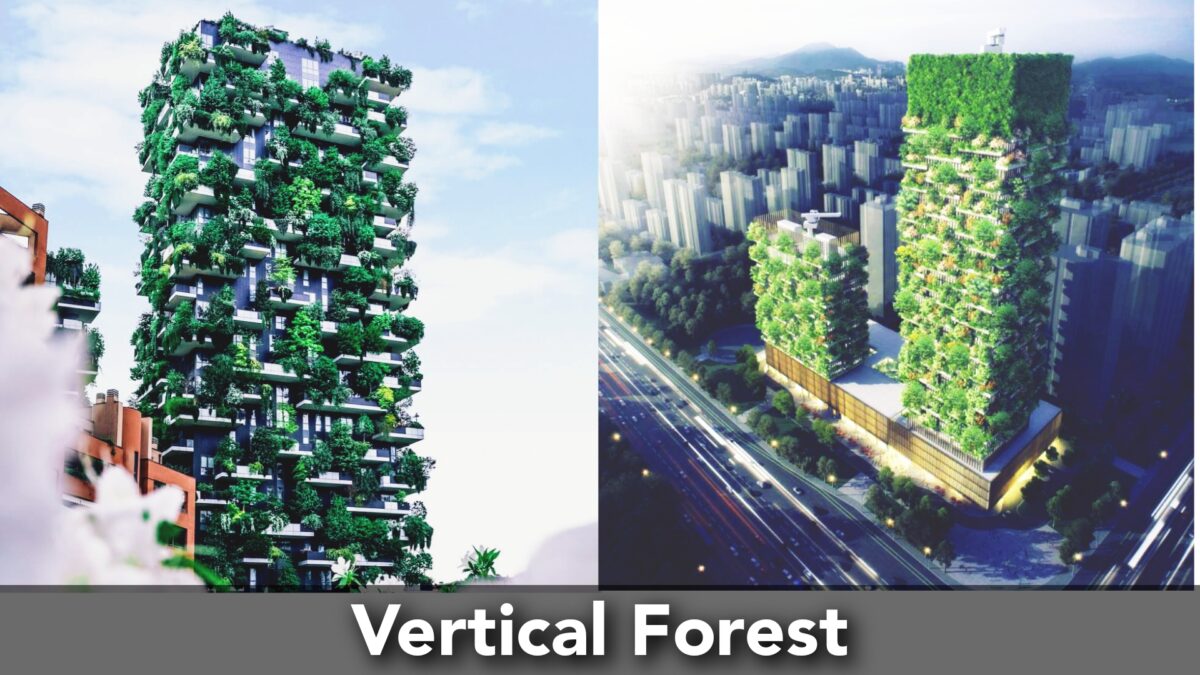Table of Contents
What Is Vertical Forest?
Vertical forest, also referred to as “vertical garden” or “green façade,” are a captivating architectural concept that involves seamlessly blending vegetation, including trees and plants, into the design of buildings or structures.

The underlying idea behind vertical forests is to establish a harmonious relationship between urban development and nature by integrating extensive plantings into the vertical surfaces of edifices.
Vertical forests boast a distinct characteristic in the form of their multi-level, terraced structure, which enables the growth of a diverse array of plant species across different floors or levels of the building.
These remarkable structures are primarily implemented in densely populated urban areas where the availability of horizontal space for conventional gardens or parks is limited. By utilizing vertical surfaces, these green marvels bring nature closer to urban dwellers and enhance the aesthetic appeal of the cityscape.
Purpose
The main objective of a vertical forest is to provide sufficient room for the growth of plants. The presence of lush greenery cascading down the sides of the building is often a notable characteristic of a vertical forest. Typically spanning multiple floors, these forests offer a greater area for accommodating vegetation.
Nevertheless, this doesn’t imply that the entire floor space within a vertical forest is exclusively allocated for plants. In reality, the initial vertical forest established in Italy reserved significant space for residential purposes.
Given that the internal space of a building often lacks favorable conditions such as air circulation, adequate lighting, and other essential environmental factors for plant growth, this area is intended for human occupation.
On the other hand, the areas surrounding the building, such as balconies and terraces, are designated for vegetation. However, most vertical forests are designed in a manner that maximizes hospitable space for plants while ensuring a harmonious balance with human habitation.
Importance Of Vertical Forest
Due to industrialization, more people are movinh to cities, the villages is getting smaller and cities are getting bigger. Because of this problem, we have to find solution to fit more people in cities with sustainable development.
One really cool idea is something called vertical forests. In this method, trees are planted in the vertical dorection. It’s like having a mini forest in the middle of the city! Vertical forests make it easier and better to have greenery in cities.
The first vertical forest was built in Milan, and since then, many other countries have started building them too. Even places with lots of people, like Bangladesh and India, are making their own vertical forests.
Vertical forests are changing the way we see and experience cities. They make cities more beautiful, help clean the air, and create homes for animals.
Benefits Of Vertical Forests
- Vertical Forests provide cleaner air by absorbing carbon dioxide and releasing oxygen, helping to combat air pollution and improve the overall air quality in cities.
- They enhance biodiversity by serving as habitats for various plant and animal species, promoting a more balanced and ecologically diverse urban environment.
- Vertical Forests reduce energy consumption by providing natural shade and insulation, resulting in lower cooling and heating needs for buildings, thus reducing the reliance on artificial climate control systems.
- They mitigate the urban heat island effect, as the dense vegetation helps to cool the surrounding environment by reducing the absorption and re-emission of heat, creating a more comfortable and temperate microclimate.
- Vertical Forests improve the aesthetics of urban landscapes, adding a touch of natural beauty and greenery to the concrete jungle, enhancing the overall visual appeal and creating a sense of tranquility in the midst of a busy city.
- They contribute to noise reduction by acting as a natural sound barrier, absorbing and deflecting noise pollution, creating a quieter and more peaceful environment for residents.
- Vertical Forests promote physical and mental well-being by providing green spaces for recreational activities, such as walking, jogging, and relaxation, which can improve people’s overall health and reduce stress levels.
- They help to manage stormwater runoff by absorbing and retaining rainwater, reducing the strain on urban drainage systems and minimizing the risk of flooding during heavy rainfall.
- Vertical Forests enhance property values and attract investments by creating unique and highly desirable living and working spaces, as the presence of greenery has been shown to increase the perceived value of real estate.
- They serve as a source of inspiration and a symbol of sustainable architecture, showcasing innovative design concepts that integrate nature into urban environments and encouraging the adoption of eco-friendly practices in future construction projects.
